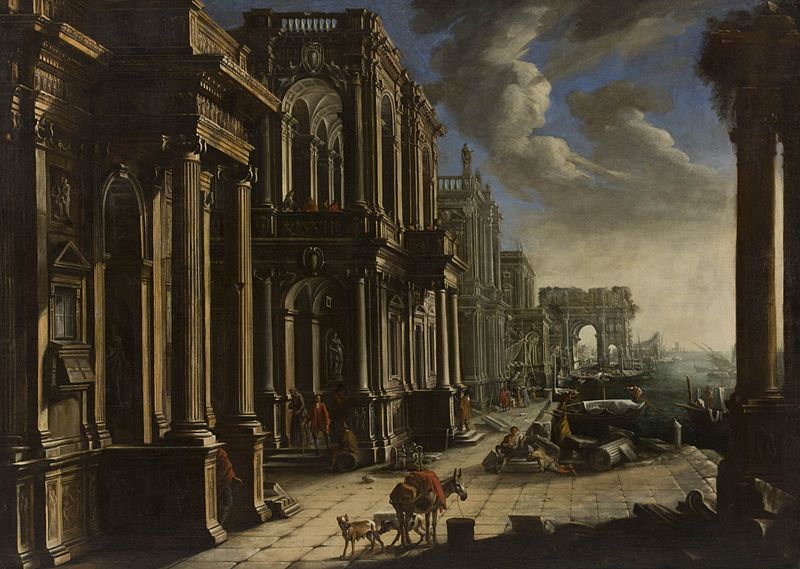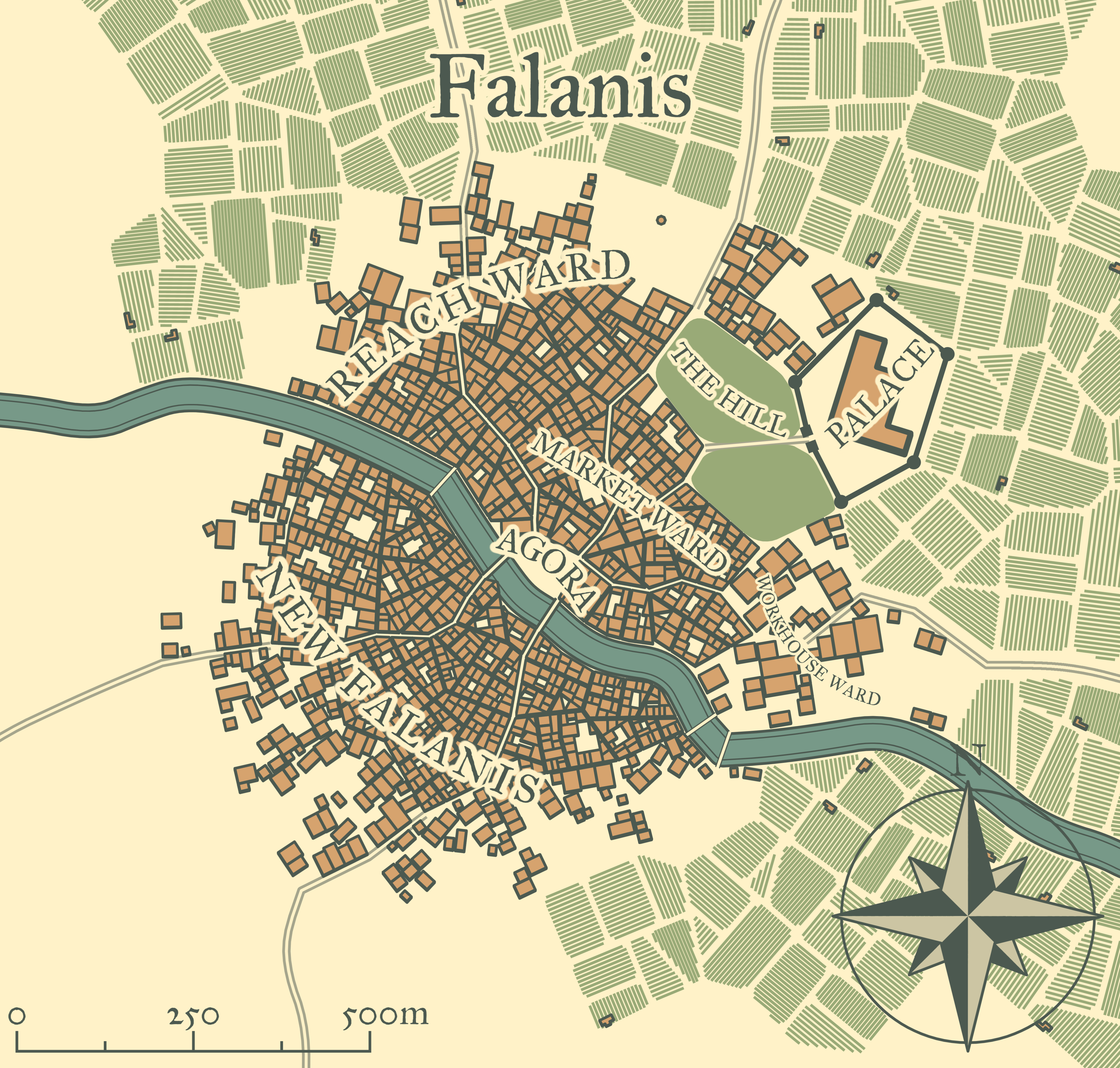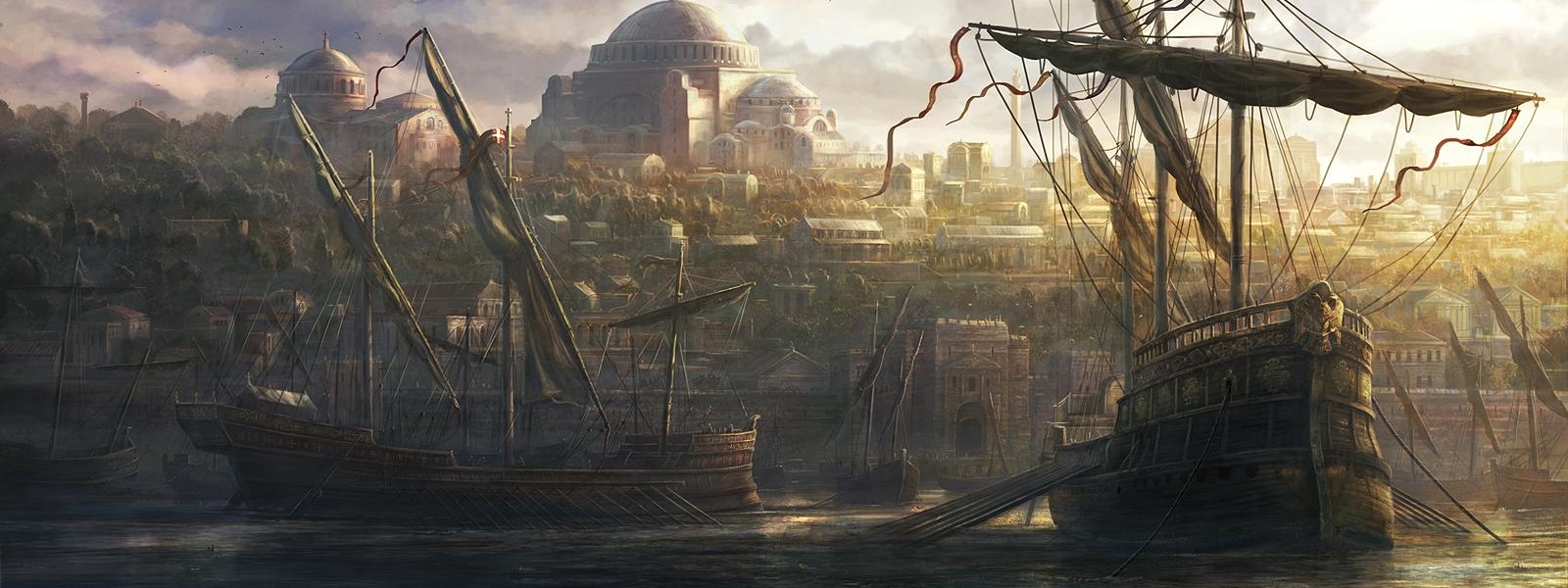Falanis (/ falanɪs /)
Φαλανισ

View with Triumphal Arch and Figures by Alessandro Salucci
Stepping off the docks and into Falanis you see a raucous city. The hum of Falanis is greater than a city its size would indicate with smallfolk and tallfolk alike run about the market stalls buying this thing or that, and working parties of gnomes and humans go off to the workhouses. Friendly merchants hawk their wears to you with smiles on their faces.An older city on the old frontier between Aeillan and Grecci territory, the city of Falanis has had a long history of being an outpost at the fringes of Aeillan lands. In the Late Imperial, the lands north of Falanis itself were conquered by the Aeillan Empire to finally completely secure its northern frontiers, and as a result, the city of Falanis became the new capital of what would become the Exarchate of Falemesia.
Wards of Falanis
The city of Falanis has five major wards, with most of the city's neighborhoods being situated north of the river Nataloi and the most recently settled neighborhoods being settled south of the river as the city has expanded.The Hill: The oldest and most politically important ward of the city of Falanis, The Hill is the location of the city's Palace, the estates of the wealthy, and the nominal hill that is used as a public green and festival space.
Market Ward: Home to the city's agora, its river jetties, and a fair amount of the skilled tradespeople living in the city of Falanis, the market ward is the go-to place for travelers to go shopping, find a place to sleep, and to seek out employment.
The Reach Ward: The reach ward established at the northern reach of the city is the result of a slow concentration of skilled farm workers looking for a place to live in the offseason.
New Falanis: One of the newest wards of the city of Falanis, the neighborhood of New Falanis is largely the home of Grecci migrants moving into the city to seek out greater economic opportunities.
Workhouse Ward: The newest ward of the city of Falanis, the workhouse ward is home to manufactories, and the barracks for those who work in them, a relatively poor region, with little of interest to foreign travelers.
Important Locations
The Hill: Centerpiece of the Hill Ward, the Hill is the civic center of the city of Falanis, as the drill square for the local garrison, a festival area, and as the primary place where news can be heard about governance or affairs in other cities.The Agora: The primary central marketplace in the city, the Agora is where most of the citizenry can find products from through Falemesia, as well as goods imported by traveling merchants.
The Oakenshield Tavern: An ancient tavern run by a prominent Volgier family for several centuries, it is a long-standing, and high prestige adventurer's tavern where many of the city's elite to pick up potential blades for hire.
The Brotherhood of Gnomes Guildhouse: A guildhouse that specifically caters to the interests of the Grecci residents of the city, the Brotherhood of Gnomes is a hotbed of political activity that many seek to pay adventurers to support, infiltrate, or disrupt.
Demographics
The population of Falanis is a fairly small city by the standards of Aeillan capitals with a total population of 21,074 denizens. As Falemesia is relatively committed to peaceable relations between its dominant ethnicities, it has an unusually high percentage of full citizens with almost the entire adult population (15,076) being citizens, with the noncitizen freemen largely consisting of a handful of recent immigrants and children who are considered wards of their parents until they reach adulthood. The bulk of Falanis' population is Ilosi Aeillans, with a sizable minority of Grecci gnomes making up the rest of the core of the population. There are smaller minorities of humans, dwarves, and other peoples that round out the whole of the populace.
Government
As the capital of the Exarchate of Falemesia, the city of Falanis is governed directly by the crown itself. Falemesia is a relatively democratized, principate Exarchate, however, and much of the power of the monarchy is shared with the Falemesian Eldership Council, which likewise takes residence, as an institution, in the palace. In the day-to-day operations of the city, the council has appointed a small, but respectably efficient civil service, largely to manage tax collection and law enforcement services.
Defences
The city of Falanis lacks a city wall, instead of possessing a small citadel. Instead, a fair share of the city's defenses is its defenders, with a full Bandon of the Falemesian Penandroi, as well as a sizable city militia. These troops are some of the most well equipped in all of Falemesia. Lastly, a handful of ballistae mounted on the citadel keep airborne threats, particularly wyverns, and wyvern cavalry at bay.
Industry & Trade
The city of Falanis is still at the heart of the agricultural and commercial settlement, with the bulk of the city's populace, tied up tending the fields, and manning the markets of the agora. Indeed, Falanis' primary function as a city in the modern era, is as a transit hub for goods flowing in from the interior of the Exarchate into the Ilos River. There is however a small industry that has been built around a new series of workhouses performing unskilled and semiskilled labor.
Infrastructure
The city's infrastructure is quite rudimentary with only a handful of, largely unpaved roads, and one major one. There is no water management system in place, and the extant underground apparatuses for such developments (left behind by prior civilizations) have largely decayed well past the point of irreparability. Uniquely, however, thanks to the efforts of Grecci inventors, there are effective clocks that manage time in the city, and allow workers in the workhouses and the fields, to plan their work more efficiently than in other cities.
Guilds and Factions
The city of Falanis is rife with political intrigue with the various factions competing for influence in the Falemesian Eldership Council. The interests of the landed class are the strongest, with the ethnically Aeillan aristocracy being incredibly influential in the council. The second most powerful force is the Brotherhood of Gnomes which represents the interests of the Grecci peoples in Falemesia, and the city itself, particularly the wealthy monied interests. Lastly are the guilds which represent the interests of skilled laborers, particularly smiths, masons, and navigators. Though rivalries are often intense, relatively tight political control and strong rules regarding civil discourse keep factionalism from breaking out into street violence.
History
The city of Falanis was settled in the later Ilosi Republic, as a trading post and frontier settlement between the Ilosi Republic and the Grecci kingdom that had dominated the region for an extended period of time. Falanis remained relatively small and unimportant thanks to the relatively insular nature of the Grecci people and the greater import of other close cities, such as Apepsos absorbing the attention, and public works funding of the Ilosi, and later Aeillan government.
In the Late Imperial period, as the Aeillan Empire began to go into decline concerns about the security of Aeilla's borders, and especially of Apepsos meant that the Grecci kingdom which had largely been unworthy of conquest in the past became an important strategic objective. The Grecci territories were seized in a lightning campaign, and the city of Falanis was made the capital of a smaller province of the Empire, and later an Exarchate.
When the Aeillan Empire crumbled after the end of the Feloran Invasions, the newly independent Exarchate of Falemesia was one of the few culturally diverse territories of the old empire, and the new government had to contend with the influx of Grecci peoples into the city. As the Reforging Era has continued, Falanis grew increasingly culturally diverse, and increasingly integrated into the Ilos River trade network as the Exarchate harnessed the resources from their hinterlands.
Geography
Falanis is located on the banks of the River Nataloi, with most of the city based on the northern bank. The city was initially located on the hills overlooking the river itself but has steadily expanded towards the riverbank, subsuming the old docks, and indeed with a new community forming on the opposite bank. The city is near a lot of fertile lands, which supplies most of the food required for the sustenance of the Falani population, except in poor years where imports are necessary.

Map of Falanis by Javak
Founding Date
EF 461
Type
Large city
Population
21,074
Inhabitant Demonym
Falani, Falanis
Location under
Owner/Ruler
Ruling/Owning Rank
Owning Organization


